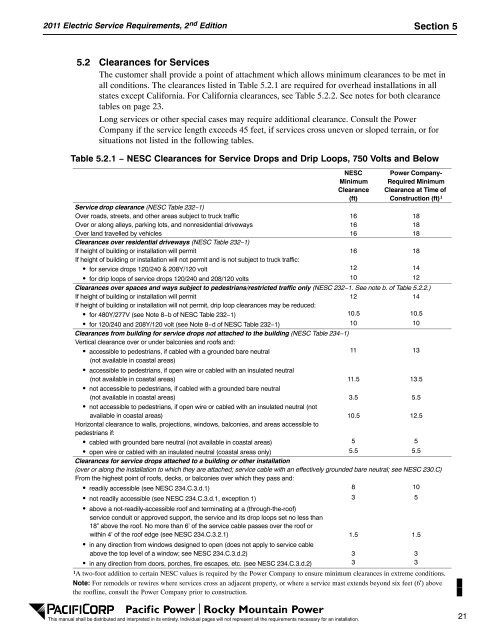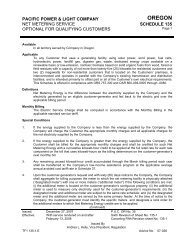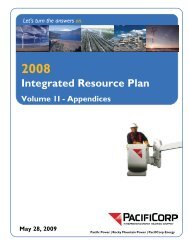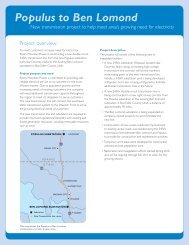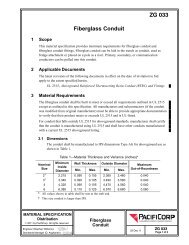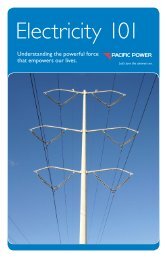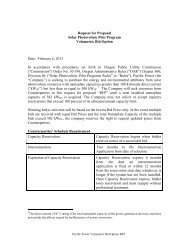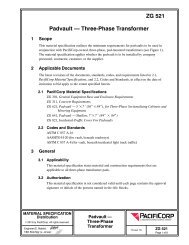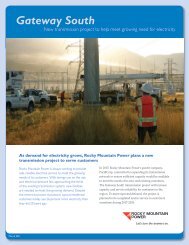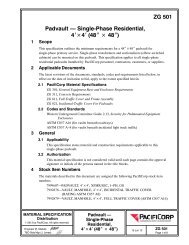2011 Electric Service Requirements Manual, 2nd - Pacific Power
2011 Electric Service Requirements Manual, 2nd - Pacific Power
2011 Electric Service Requirements Manual, 2nd - Pacific Power
Create successful ePaper yourself
Turn your PDF publications into a flip-book with our unique Google optimized e-Paper software.
<strong>2011</strong> <strong>Electric</strong> <strong>Service</strong> <strong>Requirements</strong>, 2 nd Edition<br />
Section 5<br />
5.2 Clearances for <strong>Service</strong>s<br />
The customer shall provide a point of attachment which allows minimum clearances to be met in<br />
all conditions. The clearances listed in Table 5.2.1 are required for overhead installations in all<br />
states except California. For California clearances, see Table 5.2.2. See notes for both clearance<br />
tables on page 23.<br />
Long services or other special cases may require additional clearance. Consult the <strong>Power</strong><br />
Company if the service length exceeds 45 feet, if services cross uneven or sloped terrain, or for<br />
situations not listed in the following tables.<br />
Table 5.2.1 − NESC Clearances for <strong>Service</strong> Drops and Drip Loops, 750 Volts and Below<br />
NESC<br />
Minimum<br />
Clearance<br />
(ft)<br />
<strong>Power</strong> Company-<br />
Required Minimum<br />
Clearance at Time of<br />
Construction (ft) 1<br />
<strong>Service</strong> drop clearance (NESC Table 232−1)<br />
Over roads, streets, and other areas subject to truck traffic 16 18<br />
Over or along alleys, parking lots, and nonresidential driveways 16 18<br />
Over land travelled by vehicles 16 18<br />
Clearances over residential driveways (NESC Table 232−1)<br />
If height of building or installation will permit 16 18<br />
If height of building or installation will not permit and is not subject to truck traffic:<br />
for service drops 120/240 & 208Y/120 volt 12 14<br />
for drip loops of service drops 120/240 and 208/120 volts 10 12<br />
Clearances over spaces and ways subject to pedestrians/restricted traffic only (NESC 232−1. See note b. of Table 5.2.2.)<br />
If height of building or installation will permit 12 14<br />
If height of building or installation will not permit, drip loop clearances may be reduced:<br />
for 480Y/277V (see Note 8−b of NESC Table 232−1) 10.5 10.5<br />
for 120/240 and 208Y/120 volt (see Note 8−d of NESC Table 232−1) 10 10<br />
Clearances from building for service drops not attached to the building (NESC Table 234−1)<br />
Vertical clearance over or under balconies and roofs and:<br />
accessible to pedestrians, if cabled with a grounded bare neutral<br />
11 13<br />
(not available in coastal areas)<br />
accessible to pedestrians, if open wire or cabled with an insulated neutral<br />
(not available in coastal areas) 11.5 13.5<br />
not accessible to pedestrians, if cabled with a grounded bare neutral<br />
(not available in coastal areas) 3.5 5.5<br />
not accessible to pedestrians, if open wire or cabled with an insulated neutral (not<br />
available in coastal areas) 10.5 12.5<br />
Horizontal clearance to walls, projections, windows, balconies, and areas accessible to<br />
pedestrians if:<br />
cabled with grounded bare neutral (not available in coastal areas) 5 5<br />
open wire or cabled with an insulated neutral (coastal areas only) 5.5 5.5<br />
Clearances for service drops attached to a building or other installation<br />
(over or along the installation to which they are attached; service cable with an effectively grounded bare neutral; see NESC 230.C)<br />
From the highest point of roofs, decks, or balconies over which they pass and:<br />
readily accessible (see NESC 234.C.3.d.1) 8 10<br />
not readily accessible (see NESC 234.C.3.d.1, exception 1) 3 5<br />
above a not-readily-accessible roof and terminating at a (through-the-roof)<br />
service conduit or approved support, the service and its drop loops set no less than<br />
18” above the roof. No more than 6’ of the service cable passes over the roof or<br />
within 4’ of the roof edge (see NESC 234.C.3.2.1) 1.5 1.5<br />
in any direction from windows designed to open (does not apply to service cable<br />
above the top level of a window; see NESC 234.C.3.d.2) 3 3<br />
in any direction from doors, porches, fire escapes, etc. (see NESC 234.C.3.d.2) 3 3<br />
1 A two-foot addition to certain NESC values is required by the <strong>Power</strong> Company to ensure minimum clearances in extreme conditions.<br />
Note: For remodels or rewires where services cross an adjacent property, or where a service mast extends beyond six feet (6') above<br />
the roofline, consult the <strong>Power</strong> Company prior to construction.<br />
This manual shall be distributed and interpreted in its entirety. Individual pages will not represent all the requirements necessary for an installation.<br />
21


